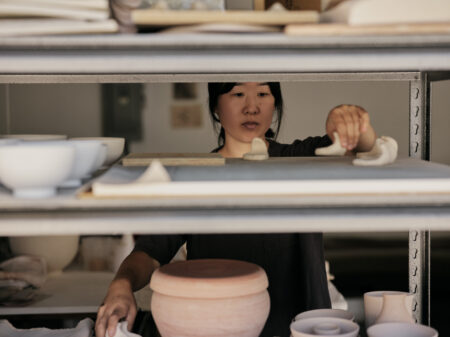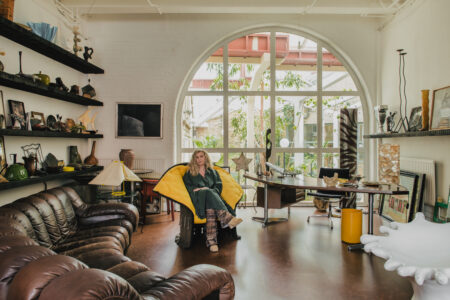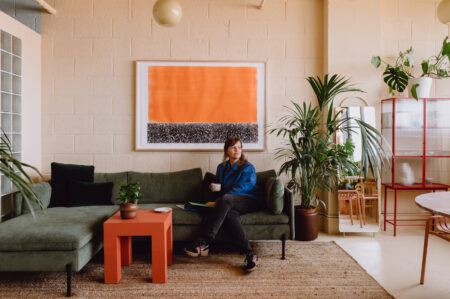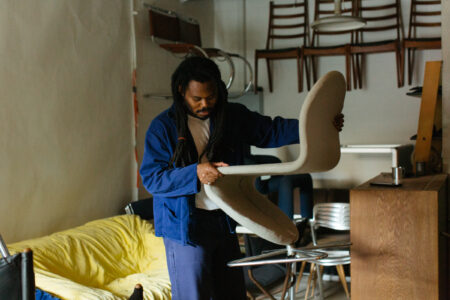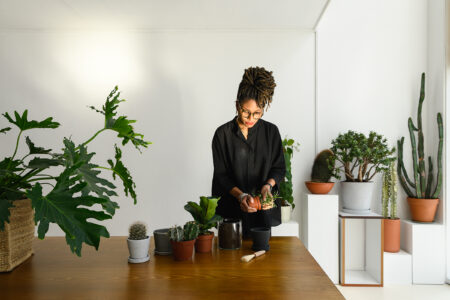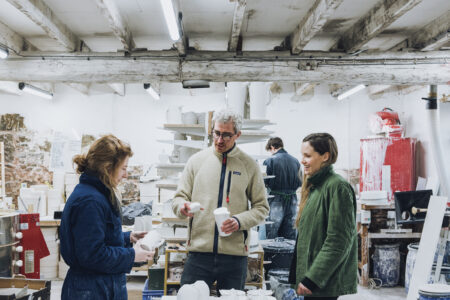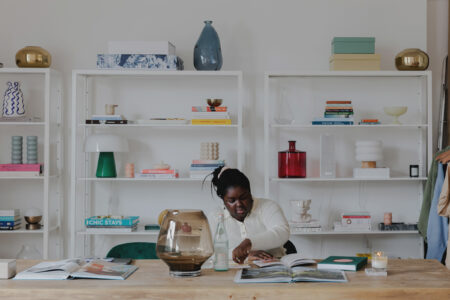Father Studio, creators of our sonic identity, on why sound is an integral part of design

Words Charlie Monaghan
Photography Elliot Sheppard
Production Allie Turner
It’s early September and a late-season summer heatwave is pushing temperatures in London to over 30 degrees. Stepping into Freddie Webb and Joe Farley’s studio in a Victorian warehouse building in Camberwell, we walk into a custom-built, sonically sealed recording room with – to our surprise and delight – air conditioning. “The coldest room in south-east London,” jokes Joe. Along with the luxury of temperature control and sonic insulation, there are also all the instruments, gear and gadgets needed to create music and sound for brands like Nike, Aston Martin, Rapha and Cos.
But it wasn’t always this way. Back in their early twenties, Freddie and Joe’s set-up was more lo-fi: Freddie’s bedroom in his mum’s house was where the two began making music together. Humble it may have been, it didn’t prevent them from making music that resonated with people – ‘ideas over equipment’ is a mantra they still work by today. Ideas and creativity are certainly what attracted us to working with them – that’s right, their latest client is us. We tasked the duo to come up with the music for our podcast, Homing In, and we couldn’t be happier with how they responded to an admittedly tricky brief. Read on to hear more about their creative process and how they approached making our new sonic identity.




Fred: “The two of us met just down the road. Joe was curating an exhibition with a mutual friend of ours who I was in a band with.”
Joe: “Fred lent me his bike! And then I joined the band and the two of us just kept making music even after that band fizzled out. We would just hang out and make music.”
Fred: “The music we were making was kind of experimental and ambient. I started playing the guitar when I was 10 and listened to lots of shoegazey bands like Pavement and Dinosaur Junior, but then I also liked electronic music, which is more where Joe comes from musically.
“We complement each other, and we think the same. When you find someone you make music with intuitively, there’s a really nice back-and-forth where the output feels very instinctive. So we kept making music without any purpose.”
Joe: “It was just a nice way to form a friendship and it was an incubator for our creative partnership, looking back. When you hang out and make music you’ve got a bit of a purpose – even though you’re not really doing anything, it feels like something. People would ask us why we weren’t out clubbing when we’d just be in on a Friday night, making music in Fred’s bedroom at his mum’s house. We were 21.”
Fred: “We were both working as runners at production companies in Soho, meeting lots of people and not really having much of a plan.”
Joe: “It’s a great job at that age because it’s fun, varied and you meet a lot of people from lots of different industries.”
Fred: “About that time people started to hear some of our music.”
Joe: “Kind of serendipitously. We were kind of thinking about how we could make music for projects, but it seemed like such a closed world. Everyone we knew who was making music for commercials were much older than we were.
“Until people came to us and said, ‘We like your music, it could be used for this,’ we didn’t realise how simple it could be. If a director likes your music, they can use it.”
Fred: “We worked with a director called Matt Lambert, who is amazing, on some stuff for the British Fashion Council, and it seemed to go well. We then got an opportunity to pitch on a car commercial, which had a fee that was like winning the lottery for us at that time. We were the definite underdogs, making music in my bedroom.”
Joe: “Winning that project felt like how I imagine a sportsman feels winning something big. It was a real triumph when we heard. Something like that validates your creative intention because the response is what you’d hope it to be.
“And then anything seems possible, because it doesn’t get much bigger than making music for a car commercial, or it didn’t at the time. It was cool because it also broke down some of the prestige you think goes with making that kind of music – we made it on a laptop on quite rudimentary stuff, but the ideas were cool. We thought we were going to be sussed out at the mix where they put everything together. We were still runners at the time, so even sitting on the sofa in that studio felt weird, but the sound mix engineer said, ‘Great work on the track, I really like it.’”
Fred: “That gave us the confidence to quit our job as runners and take on a little studio space.”


Fred: “One of the reasons we called it Father was because our band had made a song of the same name. My father had passed away not too long before, but I’m reluctant to say that’s why it’s called Father. Unquestionably, though, it was a factor. We both had complicated relationships with our fathers, and it was about creating our own father, in a way.”
Joe: “In your early twenties I guess you’re becoming an adult and you realise it’s up to you which path to take. That sounds grandiose; maybe we’re post-rationalising. But it really felt like an opportunity at a point when we were both unsure of what we wanted to do, to build for ourselves a viable career that would work both financially and creatively. It felt like a big thing.”
Fred: “I think what happened then, over ten years or so to where we are today, was really dictated by what other people saw within us, and how they could utilise our work. In 2014 we were commissioned to do a project called The Sound of Cos and that’s when we started to push beyond music for commercials, and started to look at music as an integral form of design. And then soon after we were commissioned by an industrial design company to create sounds for hardware. I don’t think we had ever thought our work could be utilised in that area.
“As a studio we try and show sound as an integral part of design and push it outside of broadcast work. We’ve had work commissioned by the V&A, situated in one of their gallery spaces. We’ve done a project recently for GF Smiths where we created a sound for each colour in their colour plan. We’ve very interested in how to utilise sound across lots of touchpoints and sectors to elevate and heighten experiences, which is how we ended up working for The Modern House.
“As we got the email from you guys we were on our way to see the designer Tom Hingston, who did quite a few of the Massive Attack album covers artworks, stuff for Grace Jones, and other prestigious projects. We definitely felt we were knocking on the right doors to attract the kind of work we want to be doing.”


Joe: “It was a genuinely memorable moment. It’s a brand we both really admire and respect, and we spend a lot of time looking at houses on the site.
“And it was the first podcast project we’d ever worked on, and that was really great because when you’re a fan of a medium, it’s nice to feel like you have contributed to it in some way.”
Fred: “We know the brand very well, so we were very sensitive to tonalities and pacing. We knew that keeping a fairly neutral palette to allow for all sorts of conversations that happen on Homing In was important. Home is such an emotional space, in positive ways but also challenging ones, so it was important the music made space for all the feelings we have about home to exist.
“We also wanted to conjure up this idea of immersing yourself in a space. And we wanted to make sure there was a lot of space in the composition itself, not overdramatising or trying to push an angle too much. It was really letting the listener position themselves in the content.
“I think making music neutral is quite hard because you push into an area that’s very sad or melancholic, or very happy. So finding a piece of music that allows you to feel both was the challenge.”
Joe: “The right brief is so important, because you then have a structure to work within, and it allows you to find a nice lane to work in that has freedom, but isn’t so open-ended that it could be anything. The infinite is quite incapacitating. Creating conceptual approaches before you’ve made any music is so important.
“Not that you need a purpose for any kind of creative endeavour, it’s just when you’re answerable to someone else it really does push the process along! We’ve taken that method back into what we do outside of Father, with our various other musical endeavours. We have a band together, which is essentially the same one we were in when we were in our early twenties, but we’ve only just got the place now where we can give it more attention. Knowing how to approach and structure a creative project, even if it’s just for yourself, has been a really valuable skill to learn because it means we finish stuff!”
Fred: “The future is to really push into areas of sound that aren’t obvious pathways. I think the thing we would like to do most is use sound as a way to improve certain circumstances. I’ve spent a lot of time in the hospital this year with my daughter, and because I work with sound a lot, I become very attuned to the sound of medical devices and what they signify. I think there is so much opportunity to create better experiences for patients, so I’d be really interested in working with sound in a medical environment. I think we all understand how important sound is, but I think it takes having a conversation to really engage people and get them excited about it.
Joe: “We want to work on projects that involve physical spaces too. We worked on a couple of theatre projects and it was amazing to dip our toes into that world, to collaborate with lighting people, stage builders and movement directors. Collaboration is not only important, it’s also so enjoyable, so we really want to seek that out – there’s no real limit that way.
“Or our band project will take off, and we’ll pack it all in and go on tour. That’s the other option!”





